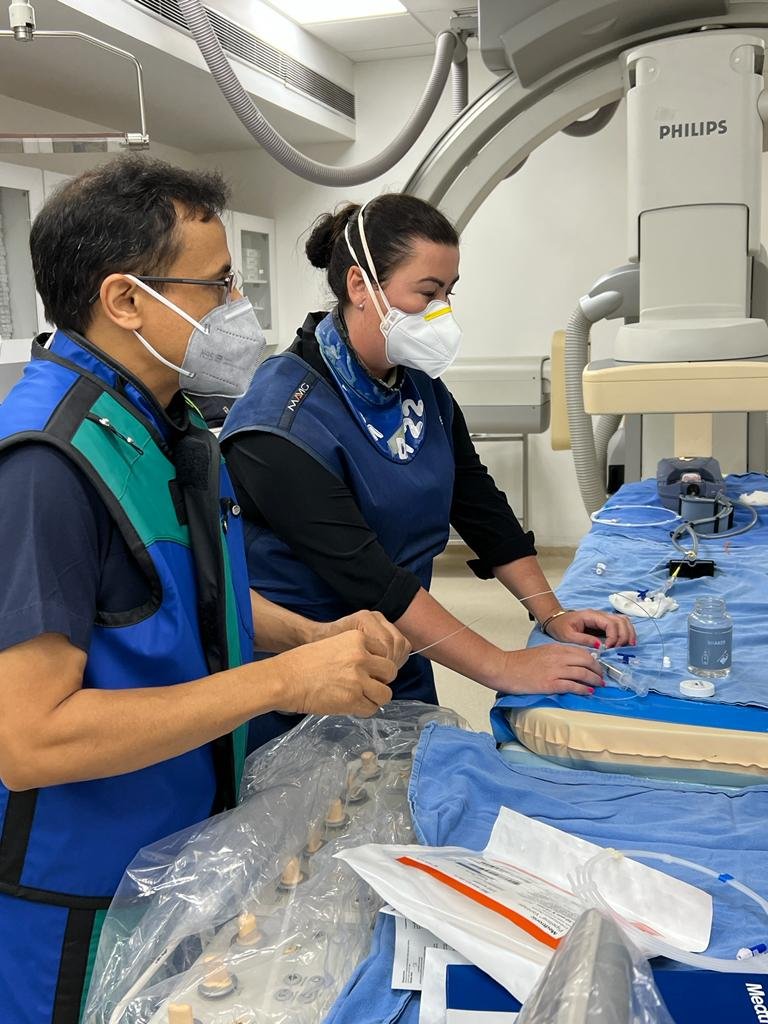The patient had a brain hemorrhage a few years back due to a ruptured aneurysm for which she was treated by coiling in the emergency period, where she made a complete recovery. However, due to the badly damaged blood vessel, a small part of the aneurysm had to be spared which on follow-up angiography started to grow again. Since the patient was at risk of repeat hemorrhage and the aneurysm which had grown again was not possible to be treated by coiling, the team decided to use a flow diverter.
“We are proud to have performed the first case of using Pipeline Vantage flow diverter in the country. Practised delivery in a flow model to get a feel of the device followed by a case of complex MCA aneurysm. The combination of lower profile as well as shield technology (which reduces platelet aggregation on the device) is likely to make it a useful device for flow diversion in distal aneurysms. Since the aneurysm was on a small blood vessel, we used the latest Pipeline Vantage device. The procedure was successful and the patient made a complete recovery. The thinner device which could be placed through smaller tubes made the procedure possible and safer. This device can be used to treat many more patients with complex brain aneurysms quite successfully using the modern generation flow diverter device” said Dr. Vipul Gupta, Director, Neurointervention, Agrim Institute for Neurosciences, Artemis Hospital
Cerebral aneurysms are swelling in the blood vessel of the brain due to the weakening of its walls causing a bulgy appearance. These aneurysms can burst and cause massive bleeding in the brain known as subarachnoid hemorrhage(SAH). If not treated in time, patients tend to bleed again, and few survive the disease. SAH is always an emergency because ruptured cerebral aneurysms continue to be a significant cause of death which can be significantly reduced if treated early. Rebleed due to re-rupture of aneurysm is a very important factor, which makes early treatment all the more important. With modern surgical and interventional (endovascular) techniques, a most aneurysm can be treated with reasonable safety.
“In the previous era, open Surgery was the only option of treatment. However, problems with surgery include invasiveness and trauma to normal brain parenchyma. Thankfully, nowadays most of these patients can be treated by the minimally invasive technique of Endovascular Coiling Of Aneurysms.
However, certain complex aneurysms cannot be treated by coiling and for these patients, a Flow Diverter device is used to repair a badly damaged blood vessel of the brain. This intervention is an endovascular technique in which a cylindrical, metallic mesh stent is placed inside the blood vessel containing an aneurysm to divert the blood flow from the aneurysm. The wires of the device are built in layers so that despite its small size it is visible to the doctor on fluoroscopy. These devices are also coated with special material (Shield technology) which reduces the chances of any clot formation and one can use fewer anti-platelet (blood-thinning) drugs, improving the safety of the patient. Over time, the aneurysm heals, preventing any rupture” added Dr. Gupta.
















Social Plugin